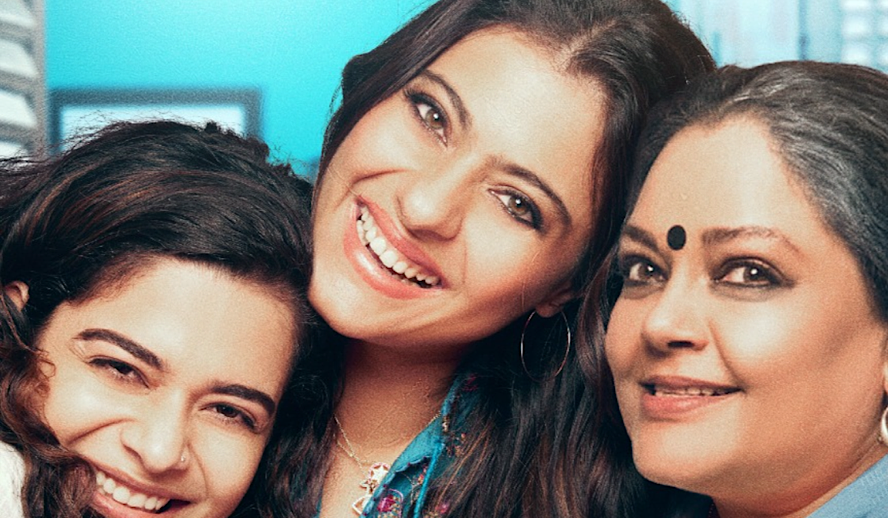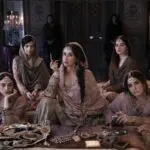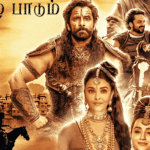Table of Contents

Photo: ‘Tribhanga’/Netflix
Since the onset of the 2020s, an extraordinarily anarchic chain of events, that include a global pandemic and an attempted coup at the U.S. Capitol, has left even the most stable of us on edge. Will there be another insurrection? When can I get the vaccine? What is the next horror in store? These questions may be useful to ask ourselves during these unprecedented times; however, we are mistaken to believe that they have become the only worth contemplating. As we cope with the terror of the past and anticipate the looming tragedies of tomorrow, the gifts of the present are surely dwindling. Indian film star turned up and coming director, Renuka Shahane, crafts space for reflection and the necessary confrontation of the present in the heartfelt and inspiring ‘Tribhanga.’
Three Generations of Women Struggle to Push Aside Their Independence
Following the story of a family made up of three generations of fiercely independent women with varying degrees of disdain and affection for the other, struggling to come to terms with the consequences of their decisions. ‘Tribhanga’ is a tribute to the complexities of the mother-daughter bond. The matriarch, Nayantara, is an elderly woman and accomplished author who’s reconciled her lonely life through means of alcohol. Nayantara’s daughter, Anu, is a famous dancer whose high profile and accumulated resentment for her mother has made her uptight and volatile.
Related article: The Masters of Cinema Archives: Hollywood Insider Pays Tribute to ‘Dil Se’, Exclusive Interview with Director Mani Ratnam
Related article: EXCLUSIVE: Ayushmann Khurrana Interview – India’s Tom Hanks is Transforming Bollywood and Indian Society while Destroying Toxic Masculinity
Finally, Anu’s daughter, Masha, is a timid, warmhearted traditional woman of faith who is taking the first steps toward having a child of her own. When Nayantara suddenly falls into a coma, Anu finds herself unable to run from the trauma of her past and face-to-face with her daunting present reality. In this present moment, ‘Tribhanga’ allows for characters to discover vital truths that had been avoided including those of family, tradition, passion, and the circular nature of life. This story is ultimately an unbiased look at the unfair consequences that independent women must face when they are more progressive than the society around them. It is a brutally raw portrait of the choices we make and how they affect those around us, both known and unknown to us.
A Fragile Family Endures in ‘Tribhanga’
Of all the themes ‘Tribhanga’ explores as it follows a few slow-moving days of one family’s lives as they await their mother’s return to consciousness, the perseverance of family is undoubtedly the most moving. The first of Tribhanga’s many thought-provoking sentiments come in Anu’s assertion that she owes her mother nothing, “When did we have a choice? Did we choose who our parents are?” This unconventional notion, that Anu’s mother later echoes, reveals the fragmented state a family can all too easily end up in and launches the impressively enormous questions of a family’s bond that Shahane bravely prompts in her film.
Subscribe to Hollywood Insider’s YouTube Channel, by clicking here.
When translated, “Tribhanga” literally means “three parts break,” an accurate representation of the state of the family and, more specifically, the broken relationship between the three women of each generation. A major motif of ‘Tribhanga’ is the trauma women are forced to undergo and rebound from time and time again, though the ripples of pain cannot be so easily erased. Through brilliant and cohesive use of flashbacks, Shahane first reveals the trauma that Nayantara experienced when she was a mother of Anu’s age. Nayantara’s life purpose was to be a writer and her dedication to her craft was not supported by her husband and even mocked by her mother-in-law who shockingly alleged that Nayantara would let her children die to focus on her books. This was the first obstacle shoved in between Nayantara and her family as she was put in a situation where she had to choose between her love of writing and her love of her children.
Anu’s rift between her mother and her is gradually revealed as her reunion with Nayantara, even if it is only at her hospital bed, causes traumatic flashbacks Anu had likely blocked out to kick in full force. Through terrifying dreams of blood and violence to debilitating memories of abuse, Anu has no choice but to reconcile with the reality of what is in the present moment: she is suffering from PTSD. Anu reveals that she was molested by her mother’s boyfriend and is still grappling with the pain of her mother not protecting her during her childhood. This results in Anu being a fierce protector of her daughter, Masha, to the point of never marrying a man.
Related article: The Power of Positivity: Ikorodu Bois + Chris Hemsworth + Russo Brothers + Sam Hargrave
Limited Time Offer – FREE Subscription to Hollywood Insider
Although this is of Anu’s best intentions, Masha shares the agony she endured not having a stable father figure, and how she blames her mother for robbing him from her. As the cycle of life and death is explored in ‘Tribhanga,’ Anu’s understanding of Masha’s pain over her lack of father highlights the cycle of family strain. Though Anu attempted to correct the flaws she found in her mother’s parenting during her own childhood, Masha reveals that she has a shared experience with Anu as a result of her perhaps over-corrected mothering. Although the rift between Nayantara, Anu, and Masha remains glaring, Anu’s realization of the pain all mothers and daughters share allows her to make peace with the horrific events of the past and forgive her mother in the present. Through this intricate dynamic, Shahane beautifully depicts the ways in which families persevere and unite through their intrinsic, divine bond.
A Unique Approach to Language Makes This Film Stand Out
The first thing that caught my attention in this film was the use of language. I want to preface this by saying that I have very little experience with Indian films, so I lack some cultural context when it comes to their employment of multiple languages. Though the film’s dialogue mainly took form in the official language of India, Hindi, there were frequent overlaps between this language and English. In ‘Tribhanga’, it is a common occurrence for the characters to switch between English and Hindi, sometimes saying a fully English sentence in the middle of a Hindi monologue. Often, they would switch between English words and Hindi words, mixing them together in sentences to more accurately describe their feelings or viewpoint. Given my lack of cultural context, I am unable to discern whether this is a common phenomenon in Hindi-based films, or if this film was unique in that manner. I can, however, speak to the effect that this language-mixing had on me as a viewer. At a base level, as a native English-speaker, this form of blended language made the film much more engaging to watch. I would be reading the subtitles, then, all of a sudden, hear a familiar word or phrase.
Related article: Hollywood Insider’s CEO Pritan Ambroase: “The Importance of Venice Film Festival as the Protector of Cinema”
Related article: The Masters of Cinema Archives: Hollywood Insider Pays Tribute to ‘La Vie En Rose’, Exclusive Interview with Director Olivier Dahan
The seemingly random way that the screenwriters threw in English words always caught me off guard, and engaged my aural skills even more so than an all-English film would. It heightened my experience of the film in that it forced me to listen carefully to the words the characters were saying, listening for bits and pieces that might resonate with my English ears. Overall, the use of blended language shows careful attention to the audience and broadens the film’s appeal beyond just native Hindi speakers. Much like the historical films of Brazil, like ‘How Tasty Was My Little Frenchman’, this intermediality of cultures and languages allows for the film to resonate with a wider audience, thus making it a more appealing watch while also capturing aspects of globalist influence on films across the world. In a period where everything has become immensely connected due to the internet, ‘Tribhanga’ reflects that in its choice of using both Hindi and English to convey its ideas. Intermediality is a powerful tool to employ when making a film, and this movie clearly reflects that in its engagement of audiences outside India.
Anger Instead of Tears: The Cost of Realistic Emotional Expression
I’d like to focus on the narrative aspects of the film that I thought succeed in pushing a feminist perspective. Firstly, the main character, Anu, is a wildly successful movie star who is unmarried with a “technically” illegitimate daughter, Masha. To put it simply, Anu is a badass. She is feisty throughout the whole film and adamantly refuses to allow anything to overtake her free will. The film does an excellent job of developing Anu’s character, exploring her childhood and the trauma that made her into the stubborn woman she is. It handles her trauma delicately, careful to not over-dramatize it, but instead use it as a tool to provide insight into both her character and her mother. Thus, Anu is a loud woman with the mouth of a sailor; she frequently drops f-bombs, to the dismay of those around her, throughout the entire film.
Related article: The Rise & Victory of Mira Nair: The Pride of Indian Representation in Cinema
Related article: ‘Never Have I Ever’: Authentic Indian Representation Results in Show’s Massive Success
What I like about Anu’s character and the way she handles trauma is similar to the reason I liked the film ‘Pieces of a Woman’ with Vanessa Kirby. Women are typically portrayed in the media as having a singular response to hardship and trauma: crying. Too often, weepy damsels in distress and princesses locked in towers simply cry instead of owning their agency and taking the necessary action to save themselves. In ‘Tribhanga’, Anu reacts to conflict in the exact opposite way. She takes action to the extreme, sometimes making rash decisions to solve her problems instantaneously. She cries very infrequently throughout the film, instead, her immediate reaction seems to be anger. I appreciate stories that display women reacting to strife with emotions other than overt sadness as I, myself, am a woman who tends to react to things with anger, not tears. It, in all honesty, makes me feel represented and seen by the media, as well as helps to fight the age-old stereotype that women are overly emotional. Anu provides a refreshing look at a truly independent woman who refuses to be silenced in times of struggle.
The Unconventional Feminism of ‘Tribhanga’
Any film that is centered around three women, directed by a woman deserves praise for its ability to come to fruition against the odds of the oppressive male-dominated industry of Cinema. Shahane’s feminist accomplishments do not end with ‘Tribhanga’s’ cast and crew, however, the theme of nonconformity in the face of India’s, and the world’s, patriarchy is directly challenged through the actions of the protagonists. The thread of upsetting conventionality begins with Nayantara’s refusal to forfeit her dream of becoming a renowned author to fulfill her society’s ideal image of a mother. Nayantara expands her feminist inquiries when she attempts to change the last name of her children to her own, challenging a tradition she found to be sexist. “Why Shouldn’t they be known by my name?” Nayantara explained her actions to rightfully claim her children as her own, “I went to court. I fought for 10 years… I dared to challenge the age-old patriarchal society.”
Related article: ‘Made in Heaven’ – The Must-See Dark Side of Crazy Rich Asians’ Indian Weddings!
Related article: Must Watch – ‘Super Deluxe’: An Oscar-Worthy Foreign Film With A Powerful Message
Nayantara’s rebellious nature had evidently been passed down to Anu, who Shahane consistently features breaking norms of what is expected of a mother, daughter, and woman. Anu’s most apparent nonconformity is in the form of her curt and often crude language, as she unapologetically drops the deemed-unladylike “F-bomb.” Even after being accused of being too vulgar, Anu feels no obligation to “correct” her speech as she authentically conveys her frustration with her mother’s incapacitated state, as any man would be unquestioned for doing. Aside from her dialogue, Anu’s feminist and socially disruptive nature is overt in the value she places in her independence. Anu finds pride in not believing marriage is a necessity, as her grim experiences with men left her a survivor of abuse. Anu’s refusal to yield to the men who have disrespected her humanity and those in her society who judge her for not following tradition and settling down exhibit Anu and Nayantara’s shared feminist ideology as well as Shahane’s empowerment of non-conformist women.
Shahane makes an important distinction with the character of Masha, a woman who appreciates the value of tradition. As she seeks marriage to a family that is on the other extreme of conformity from Anu and Nayantara, Masha breaks from the tradition her mother and grandmother set for her. Even when Anu expresses her frustration with Masha for adhering to her new family’s conservative mindset, Masha holds the same spirit as her matriarchs as she protests her mother’s expectations and demands she be accepted for her own principles, an innately feminist stance. Although their difference in ideology may act as a barrier between the mother and daughter, Shahane does not paint Masha as any less feminist, and the conflict between the two breeds the ultimate resolution of the film.
Related article: The Leaked Kamala Harris Vogue Cover: Where Do We Draw the Line Between Celebrity and Politician?
Reflective Feminism and the Responsibility of Independence
Lastly, I think the narrative theme that I appreciate most in this film is one of feminism. With the recent political climate and a strong push for women’s rights in the media, this film provides an interesting look at progressive women who face consequences for being autonomous in a society that’s not necessarily ready for them. Themes of traditionalism are commonly referenced, especially as Masha is married into a more conservative family than her mother or grandmother’s homes were. Both Anu and Nayan struggle to make the right decisions for themselves and their children.
Though ultimately both women fight for their own happiness and freedom, the film asks us to examine the cost of these unpopular, feminist perspectives on their children. I know that sounds really anti-feminist like the film is saying that there are consequences for women who disobey societal expectations, but I don’t think it’s speaking to that at all. It’s simply trying to give us, as the viewer, insight into how the progressive choices the women make affect those around them. There are pros and cons to every situation, and that’s truly what the film is getting at. The women never seem to regret their choices of independence, but they do strive to acknowledge the inadvertent damage these choices can have, especially in a society that hasn’t fully been sold on the whole “feminism” thing yet.
Related article: Top 5 Female Empowerment Shows on Netflix to Watch With Your Girlfriends
Related article: 21 Awesome Female Action Movies to Watch
I have to say, I was really pleasantly surprised by this film. Having never seen a film produced in India before (I know it’s embarrassing), this was an extremely progressive take on a lot of societal issues that accompany a movement towards feminism. The multi-language canon of ‘Tribhanga’ made it aurally more engaging than I was expecting it to be. The feminist narrative themes ask independent women to reflect on their independence and acknowledge the damage they may have done to others in the process while maintaining that women are autonomous creatures. Through Shahane’s tumultuous yet enduring depiction of three women whose experiences harmonize as one, ‘Tribhanga’ serves as an everlasting reminder of the different ways families can dissent, fall apart, and reunite time after time. My interpretation of the film was that it was a story that places women on the same level as men: sure, we have the freedom and independence to make our own choices, but that comes with responsibility, something that is not necessarily examined closely in most other feminist films.
Ultimately, the film mediates on women’s independence without portraying it as necessarily good or bad. It just asks the characters to reflect on their choices, while still pushing a feminist agenda that encourages women to make decisions for themselves.
‘Tribhanga‘ is available to stream on Netflix.
Starring: Kajol, Kunaal Roy Kapur, Tanvi Azmi, Mithila Palkar
Director/Writer: Renuka Shahane
Cinematography: Baba Azmi
Producers: Parag Desai, Ajay Devgn, Deepak Dhar, Sapna Malhotra, Siddartha P. Malhotra, Rishi Negi
By Caroline Adamec and Christopher Davis
Click here to read Hollywood Insider’s CEO Pritan Ambroase’s love letter to Black Lives Matter, in which he tackles more than just police reform, press freedom and more – click here.
An excerpt from the love letter: Hollywood Insider’s CEO/editor-in-chief Pritan Ambroase affirms, “Hollywood Insider fully supports the much-needed Black Lives Matter movement. We are actively, physically and digitally a part of this global movement. We will continue reporting on this major issue of police brutality and legal murders of Black people to hold the system accountable. We will continue reporting on this major issue with kindness and respect to all Black people, as each and every one of them are seen and heard. Just a reminder, that the Black Lives Matter movement is about more than just police brutality and extends into banking, housing, education, medical, infrastructure, etc. We have the space and time for all your stories. We believe in peaceful/non-violent protests and I would like to request the rest of media to focus on 95% of the protests that are peaceful and working effectively with positive changes happening daily. Media has a responsibility to better the world and Hollywood Insider will continue to do so.”
Ways to support Black Lives Matter Movement to end systemic racism
More Interesting Stories From Hollywood Insider
– Want GUARANTEED SUCCESS? Remove these ten words from your vocabulary| Transform your life INSTANTLY
– Compilation: All James Bond 007 Opening Sequences From 1962 Sean Connery to Daniel Craig
– Do you know the hidden messages in ‘Call Me By Your Name’? Find out behind the scenes facts in the full commentary and In-depth analysis of the cinematic masterpiece
– A Tribute To The Academy Awards: All Best Actor/Actress Speeches From The Beginning Of Oscars 1929-2019 | From Rami Malek, Leonardo DiCaprio To Denzel Washington, Halle Berry & Beyond | From Olivia Colman, Meryl Streep To Bette Davis & Beyond
– In the 32nd Year Of His Career, Keanu Reeves’ Face Continues To Reign After Launching Movies Earning Over $4.3 Billion In Total – “John Wick”, “Toy Story 4”, “Matrix”, And Many More
Tribhanga, Tribhanga, Tribhanga, Tribhanga, Tribhanga, Tribhanga, Tribhanga, Tribhanga, Tribhanga, Tribhanga, Tribhanga, Tribhanga, Tribhanga, Tribhanga, Tribhanga, Tribhanga, Tribhanga, Tribhanga, Tribhanga, Tribhanga, Tribhanga

Caroline is currently a writer and contributor for Hollywood Insider. She believes in constant critical thinking and applied analysis when it comes to media consumption. Her goal aligns with Hollywood Insider’s mission statement, and she strives to educate readers on the nuances of the entertainment industry and to hopefully encourage them to form their own opinions on the media they consume daily.









